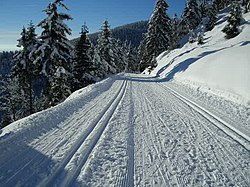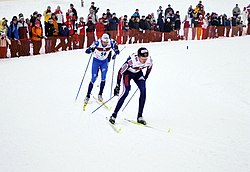Cross-country skiing
Cross-country skiing (sometimes shortened to XC skiing) is a form of skiing where the participants ski across the terrain, rather than down a hill as in alpine skiing. It has been an event during the Olympic Winter Games since the 1924 start.
 Demino Ski Marathon, 2015 | |
| Highest governing body | FIS |
|---|---|
| Nicknames | Cross-country, XC skiing |
| Characteristics | |
| Mixed gender | Separate events for men and women |
| Type | Outdoor winter sport |
| Equipment | Skis, poles, boots, bindings |
| Presence | |
| Olympic | 1924 (men), 1952 (women) |
| Paralympic | 1976 |

Cross-country Skiing Media
Sami hunter using skis of unequal length—short for traction, long for gliding—and a single pole. Both were employed until c. 1900. (1673 woodcut)
German Reichswehr military patrol on skis training in the Giant Mountains, January 1932.
Arctic travelers, Fridtjov Nansen and Hjalmar Johansen at the camp of Frederick Jackson on Northbrook Island in 1896.
Groomed ski trails for cross-country in Thuringia, track-set for classic skiing at the sides and groomed for skate skiing in the center.
Video of skiers demonstrating a variety of techniques.
Pre-1940 ski gear in Oslo: bamboo poles, wooden skis, and cable bindings.
Other websites
![]() Media related to Cross-country skiing at Wikimedia Commons
Media related to Cross-country skiing at Wikimedia Commons








